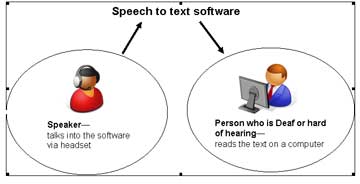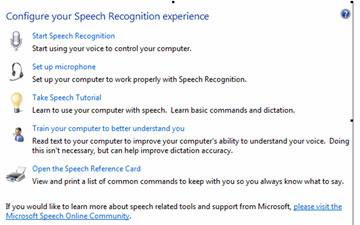|
Sangeetha Sridhar Articles |
Other useful Articles
 |
Human
friendly interactions of speaking and Hearing
( Speech
recognition & Speech technology )
By Sageetha
Sridhar
|
Talk to computers and hear
them speak
Processing information and
interacting using computing systems has taken leaps and bounds in several
directions and one such area where it brings human closer to such systems is
‘Speech Recognition’. In simple terms it is the ability to provide inputs
and instruction to computer-driven systems as normally as speaking to them
and also receive information as audio instead of text to read.
Most people consider working
with the keyboard and mouse a tiring effort affecting their health in the long
run. But provided there exist tool that enable users to enjoy the content
without having to strain to type in key words, more and more people could
readily adopt technology (including a few those who are physically disadvantaged
such as the blind).
Modes of speech technology
There are two types of areas
where this speech technology could be felt with quite an impact. One is where
the digital contents could be read out as audio without the reader having to
view it. The other is the use of audio commands to operate various software
systems.
Even in those systems where
audio inputs drive actions, there are two major applications: one with limited
vocabulary and wide-range of user and the other being large vocabulary for
limited number of users.
Common Applications

Speech recognition involves
both recognizing user’s voice inputs and responds through an automated system.
Alternatively, they may also read out free flow text from a web page as audio.
The former application is used in answering hotline queries based on pre-defined
set of phrases or menu choices.
But the latter application,
makes web-content accessible to all including those who are disabled. For
example an extra application sits above the browser interface to read out the
textual content for the users. These are broadly called as text-to-speech
technology.
Systems that are tuned to one
of few users by repeatedly recording their conversations to identify voice
patterns and accents and map them to actual words intended, are being used in
the field of transcriptions such as medicine, teaching and learning etc. Systems
that are used in these conversions are called speech-to-data systems.
Intelligence built-in
In the speech-to text systems,
the words are split into phonemes which are then mapped on to a table with
recognized phonemes and their corresponding syllables. Depending on the
sophistication of the software and hardware, this table can grow dynamically to
include new ones through speech training sessions. Such applications are use to
create electronic medical transcripts from doctor’s audio recordings.
Readers who wish to experiment
speech recognition technology can install voice-command applications in their
mobile phones or PCs, go through a training sessions to identify ambient signal
niose and later use natural voice to command such as ‘Dial Sangeetha’ or ‘Click
File Open’ commands. Users of Windows can activate their ‘speech recognition’
applications and train it to work reasonably well with voice commands.
Scope for research

Current systems are very much
dysfunctional when used with ambient noise. The prime challenges is in
cancelling the noise element, extracting pure audio and study its original
composition. Most such systems work only on one-user at-a-time basis and so
multi-user filtering is currently under study & research.
Most languages have words that
sound similar but mean entirely something different. So the suggestion as to
most appropriate word in context is learnt and improved over several sessions.
Such words and their text are held in databases which can be searched when a
mapping is required.
Languages have their own rich
collection of similar sounding words and the way in which human dialects, moods,
accents, tempo commonly make speech recognition a big challenge. Beyond the
interactive menu driven word recognition, it will be over a decade before which
a system with an acceptable level if accuracy can be available in the market.
The
author is a technology evangelist working as Consultant at the Information
Technology Authority of Oman and can be contacted at
sendsangita@gmail.com or through her blog at
http://digitaloman.blogspot.com or on twitter at
http://twitter.com/sangitasri.
| 




